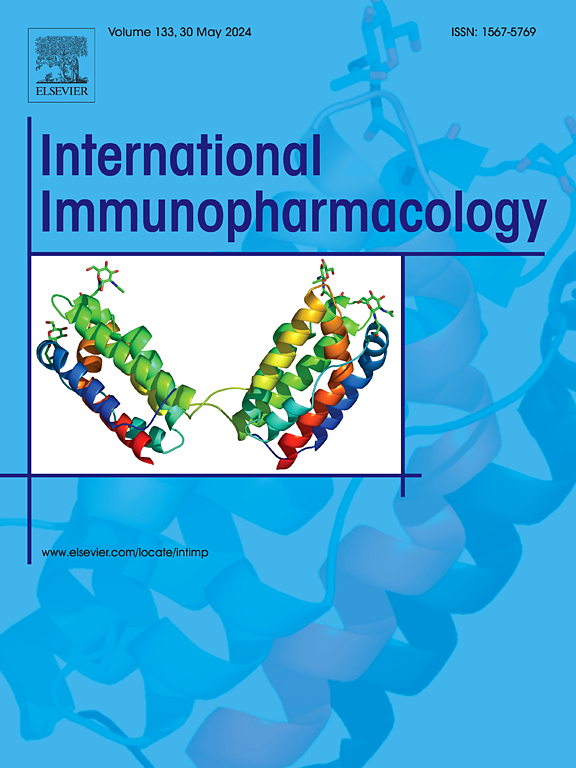Enzymatic synthesis and mechanistic insights into the hepatoprotective effects of α-monoglucosyl rutin against cyclophosphamide-induced liver injury: a multi-omics approach
IF 4.7
2区 医学
Q2 IMMUNOLOGY
引用次数: 0
Abstract
Rutin has attracted widespread attention due to its multiple pharmacological activities, but inherent defects such as poor water solubility and low bioavailability have greatly limited its clinical applications. Therefore, this study employed cyclodextrin glucanotransferase (CGTase) to catalyze the glycosylation modification of rutin, preparing rutin derivatives with improved water solubility. After optimizing the conditions, we isolated and purified 98.33 % of high-purity α-monoglucosyl rutin (α-GR), and its structure was also characterized. Subsequently, the cyclophosphamide (CTX)-induced murine liver injury model was used for activity evaluation. Our results showed that α-GR could significantly reduce liver function indicators (AST, ALT, and TBA), regulate antioxidant enzyme activities and inflammatory factor levels, and effectively attenuate CTX-induced liver injury. Furthermore, integrated metabolomics, transcriptomics, and RT-PCR analyses indicated that α-GR primarily exerts its hepatoprotective effects by intervening in key metabolites and gene expressions in CTX metabolic processes, related inflammatory responses, and oxidative stress pathways. Our results show that α-GR can effectively repair liver damage caused by CTX, thus laying the foundation for its use as a dietary supplement or therapeutic adjuvant.

酶合成和α-单葡糖苷芦丁抗环磷酰胺诱导的肝损伤的机制研究:多组学方法
芦丁因其多种药理活性而受到广泛关注,但其固有的水溶性差、生物利用度低等缺陷极大地限制了其临床应用。因此,本研究利用环糊精葡聚糖转移酶(CGTase)催化芦丁糖基化修饰,制备了水溶性提高的芦丁衍生物。通过优化条件,分离纯化了纯度高达98.33%的α-单葡糖苷芦丁(α-GR),并对其结构进行了表征。随后,采用环磷酰胺(CTX)诱导的小鼠肝损伤模型进行活性评价。结果表明,α-GR能显著降低肝功能指标(AST、ALT、TBA),调节抗氧化酶活性和炎症因子水平,有效减轻ctx诱导的肝损伤。此外,综合代谢组学、转录组学和RT-PCR分析表明,α-GR主要通过干预CTX代谢过程、相关炎症反应和氧化应激途径中的关键代谢物和基因表达来发挥其肝保护作用。我们的研究结果表明α-GR能有效修复CTX引起的肝脏损伤,为其作为膳食补充剂或治疗辅助剂的应用奠定了基础。
本文章由计算机程序翻译,如有差异,请以英文原文为准。
求助全文
约1分钟内获得全文
求助全文
来源期刊
CiteScore
8.40
自引率
3.60%
发文量
935
审稿时长
53 days
期刊介绍:
International Immunopharmacology is the primary vehicle for the publication of original research papers pertinent to the overlapping areas of immunology, pharmacology, cytokine biology, immunotherapy, immunopathology and immunotoxicology. Review articles that encompass these subjects are also welcome.
The subject material appropriate for submission includes:
• Clinical studies employing immunotherapy of any type including the use of: bacterial and chemical agents; thymic hormones, interferon, lymphokines, etc., in transplantation and diseases such as cancer, immunodeficiency, chronic infection and allergic, inflammatory or autoimmune disorders.
• Studies on the mechanisms of action of these agents for specific parameters of immune competence as well as the overall clinical state.
• Pre-clinical animal studies and in vitro studies on mechanisms of action with immunopotentiators, immunomodulators, immunoadjuvants and other pharmacological agents active on cells participating in immune or allergic responses.
• Pharmacological compounds, microbial products and toxicological agents that affect the lymphoid system, and their mechanisms of action.
• Agents that activate genes or modify transcription and translation within the immune response.
• Substances activated, generated, or released through immunologic or related pathways that are pharmacologically active.
• Production, function and regulation of cytokines and their receptors.
• Classical pharmacological studies on the effects of chemokines and bioactive factors released during immunological reactions.

 求助内容:
求助内容: 应助结果提醒方式:
应助结果提醒方式:


